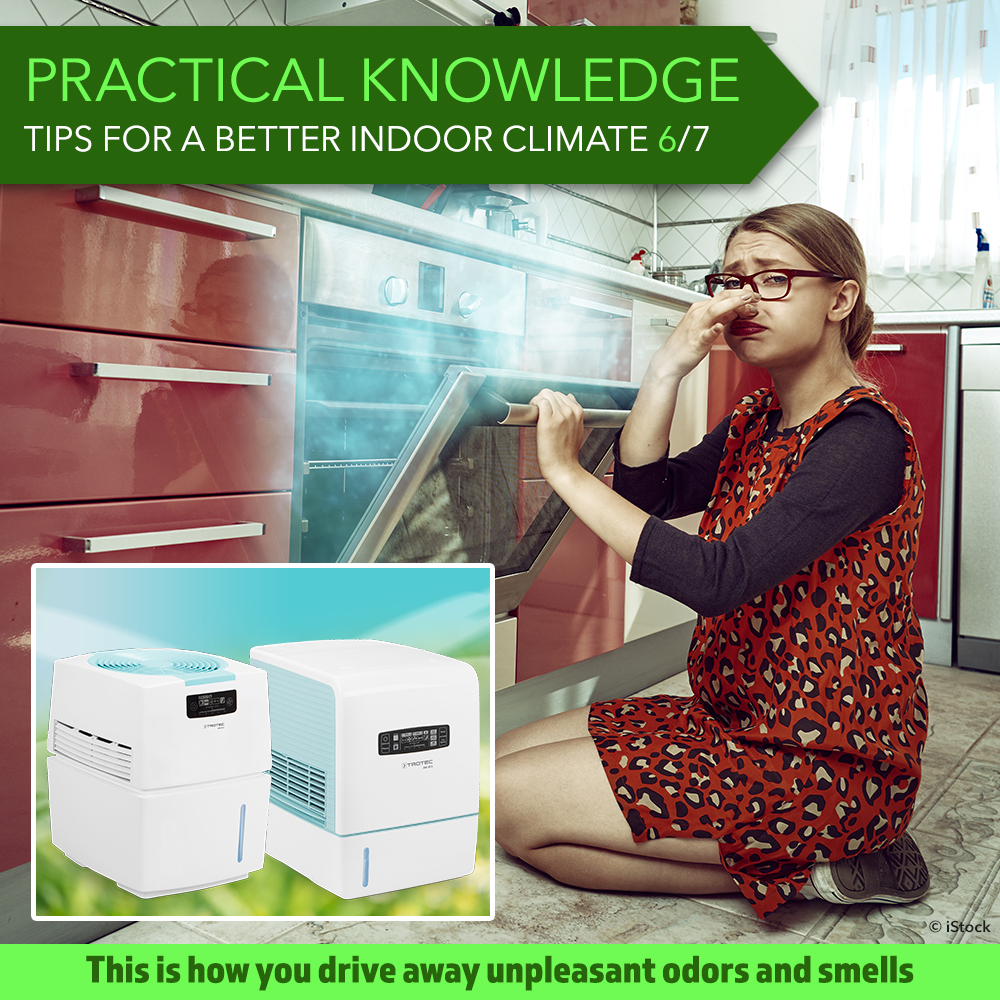 “Woahh, the air is thick in here!” Most of us will have heard this exclamation at some point – or exclaim it ourselves from time to time. For example, because of the smell of cooked food that lingers in our flats for hours despite leaving the windows open. Or because of chemicals evaporating, or the musty smell of mould. While most odours do not usually cause health problems, they can cause nausea. That’s why, in this practical knowledge series, we will give you the necessary tips to help you remove those pesky stinkers from your house and flat.
“Woahh, the air is thick in here!” Most of us will have heard this exclamation at some point – or exclaim it ourselves from time to time. For example, because of the smell of cooked food that lingers in our flats for hours despite leaving the windows open. Or because of chemicals evaporating, or the musty smell of mould. While most odours do not usually cause health problems, they can cause nausea. That’s why, in this practical knowledge series, we will give you the necessary tips to help you remove those pesky stinkers from your house and flat.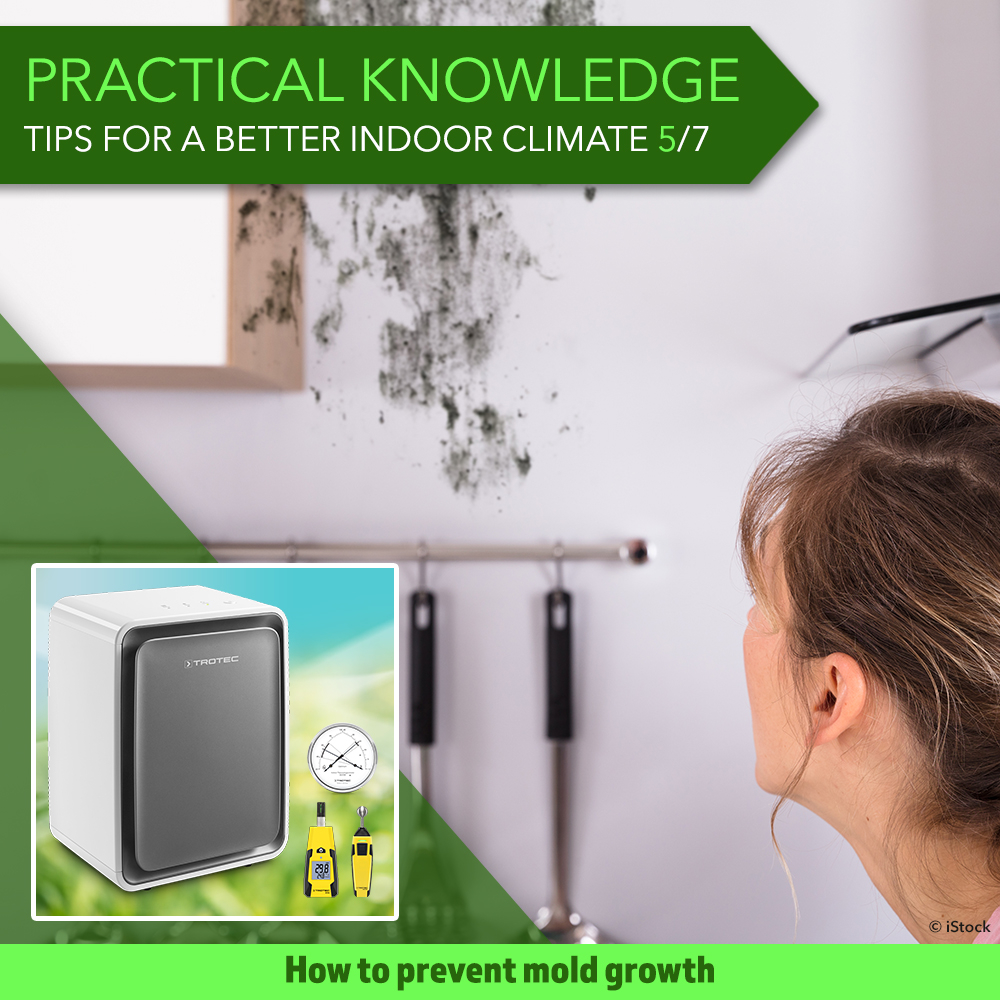 Did you know that mould forms carcinogenic toxins and has long been identified as the cause of serious allergies? An insidious enemy, then, of whose existence within their own four walls many of those affected have no idea. Because mould often nests secretly without revealing itself immediately. In the early stages, for example it hardly smells and prefers to hide behind cupboards. This is why the search for the unwanted lodger does not begin until after the initial health issues have begun.
Did you know that mould forms carcinogenic toxins and has long been identified as the cause of serious allergies? An insidious enemy, then, of whose existence within their own four walls many of those affected have no idea. Because mould often nests secretly without revealing itself immediately. In the early stages, for example it hardly smells and prefers to hide behind cupboards. This is why the search for the unwanted lodger does not begin until after the initial health issues have begun. In the last part of our Trotec practical knowledge series we discussed the dangers of very low air humidity. But the opposite, very high humidity with values above 60 percent also poses considerable health risks. Because if too much humid air circulates in the apartment, the basic requirement for strong growth of health-threatening mould is fulfilled. Hidden in the farthest corner or behind cupboards, mould soon takes on a lively life of its own. But where does the excess moisture actually come from? And what is the most elegant way to get rid of the excess?
In the last part of our Trotec practical knowledge series we discussed the dangers of very low air humidity. But the opposite, very high humidity with values above 60 percent also poses considerable health risks. Because if too much humid air circulates in the apartment, the basic requirement for strong growth of health-threatening mould is fulfilled. Hidden in the farthest corner or behind cupboards, mould soon takes on a lively life of its own. But where does the excess moisture actually come from? And what is the most elegant way to get rid of the excess? In the last few weeks, winter has once again made us feel what ‘really cold’ means. Many people at home have turned the heating knobs all the way to the left – and are now suffering from the consequences of dry heating air. It dries out our mucous membranes, reduces their cleansing function and creates an ideal habitat for viruses. It also causes undesirable effects such dry nose and irritated eyes, as well as coughs, colds and sore throats. Because low humidity also increases the lifetime of infectious corona aerosols in the room air, there is virtually every reason to humidify the air as much as possible in the future.
In the last few weeks, winter has once again made us feel what ‘really cold’ means. Many people at home have turned the heating knobs all the way to the left – and are now suffering from the consequences of dry heating air. It dries out our mucous membranes, reduces their cleansing function and creates an ideal habitat for viruses. It also causes undesirable effects such dry nose and irritated eyes, as well as coughs, colds and sore throats. Because low humidity also increases the lifetime of infectious corona aerosols in the room air, there is virtually every reason to humidify the air as much as possible in the future. Rarely has there been so much talk about ‘ventilation’ as in the past and current year. No wonder, since the exchange of air in rooms was and still is considered a tried and tested means against potential corona virus load caused by infectious aerosols. So far, there is no measuring device that is able to prove the contamination of indoor air by SARS-CoV-2. However, it is possible to determine a necessary ventilation interval via the ‘detour’ of a permanent measurement of CO2 values. Because the more people are in living rooms, office spaces, production rooms, schools and daycare centres, the more the exhaled carbon dioxide level increases – to the point of a CO2 alarm: time to open all the windows!
Rarely has there been so much talk about ‘ventilation’ as in the past and current year. No wonder, since the exchange of air in rooms was and still is considered a tried and tested means against potential corona virus load caused by infectious aerosols. So far, there is no measuring device that is able to prove the contamination of indoor air by SARS-CoV-2. However, it is possible to determine a necessary ventilation interval via the ‘detour’ of a permanent measurement of CO2 values. Because the more people are in living rooms, office spaces, production rooms, schools and daycare centres, the more the exhaled carbon dioxide level increases – to the point of a CO2 alarm: time to open all the windows! The endless corona pandemic, the start of pollen season, plus the threat of fine dust everywhere: our new Trotec practical knowledge series on the subject of indoor air could hardly be more up-to-date. Because here you will find valuable information including tried and tested tips with which you can easily improve the climate within your own four walls. In this first part, for example, you can read how the air purifiers in the AirgoClean® series can help you fight against insidious viruses, get through hay fever season with as little worry as possible, and keep harmful find dust at bay.
The endless corona pandemic, the start of pollen season, plus the threat of fine dust everywhere: our new Trotec practical knowledge series on the subject of indoor air could hardly be more up-to-date. Because here you will find valuable information including tried and tested tips with which you can easily improve the climate within your own four walls. In this first part, for example, you can read how the air purifiers in the AirgoClean® series can help you fight against insidious viruses, get through hay fever season with as little worry as possible, and keep harmful find dust at bay.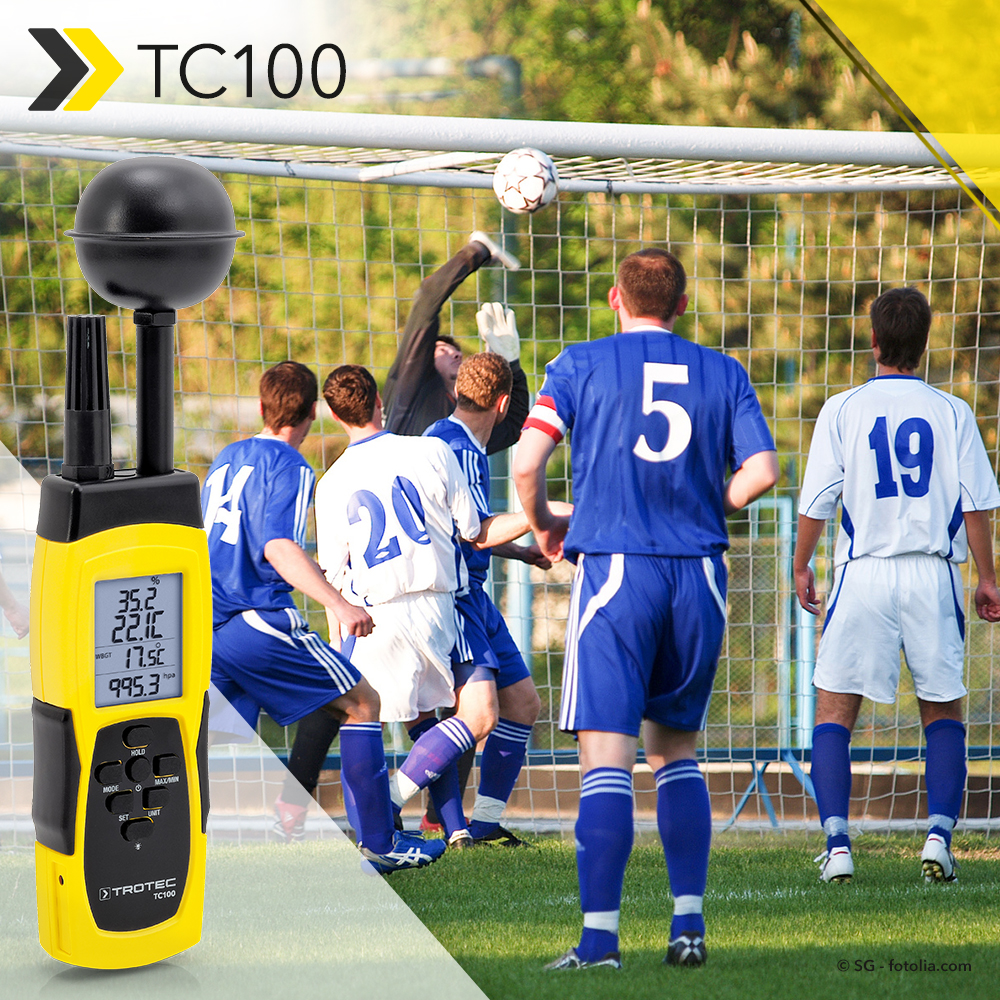 Even on hot days, there’s no time for a break on the playing field. A competitive athlete’s daily training schedule leaves no time for interruptions; tournament schedules are planned months in advance. Heat be damned! But there is a threat of heat stress, which can involve symptoms ranging from an uncomfortable heat rash to life-threatening heat stroke. To protect against this you can use the TC100 heat stress measuring device: It records the heat load on hot playing fields as well as in industrial workplaces.
Even on hot days, there’s no time for a break on the playing field. A competitive athlete’s daily training schedule leaves no time for interruptions; tournament schedules are planned months in advance. Heat be damned! But there is a threat of heat stress, which can involve symptoms ranging from an uncomfortable heat rash to life-threatening heat stroke. To protect against this you can use the TC100 heat stress measuring device: It records the heat load on hot playing fields as well as in industrial workplaces.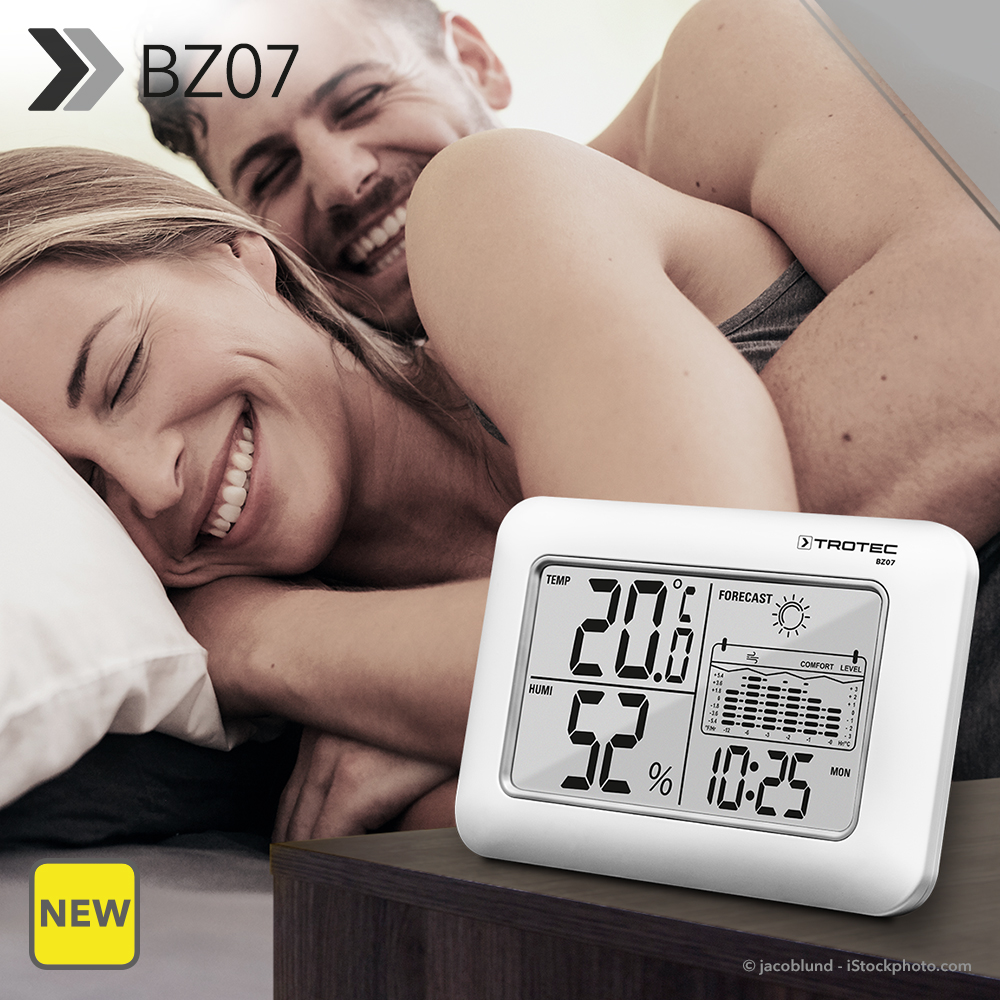 At a glance, the timelessly elegant BZ07 Thermohygrometer shows all the relevant values that are responsible for creating an optimal indoor climate. In addition to the indoor temperature and the relative humidity, there is also a feel-good indicator with three different climate levels, as well as the weather trend indicator. And thanks to the practical and easy-to-read displays for the day of the week, the date, the time and an alarm clock with a snooze function, you are always right on time.
At a glance, the timelessly elegant BZ07 Thermohygrometer shows all the relevant values that are responsible for creating an optimal indoor climate. In addition to the indoor temperature and the relative humidity, there is also a feel-good indicator with three different climate levels, as well as the weather trend indicator. And thanks to the practical and easy-to-read displays for the day of the week, the date, the time and an alarm clock with a snooze function, you are always right on time.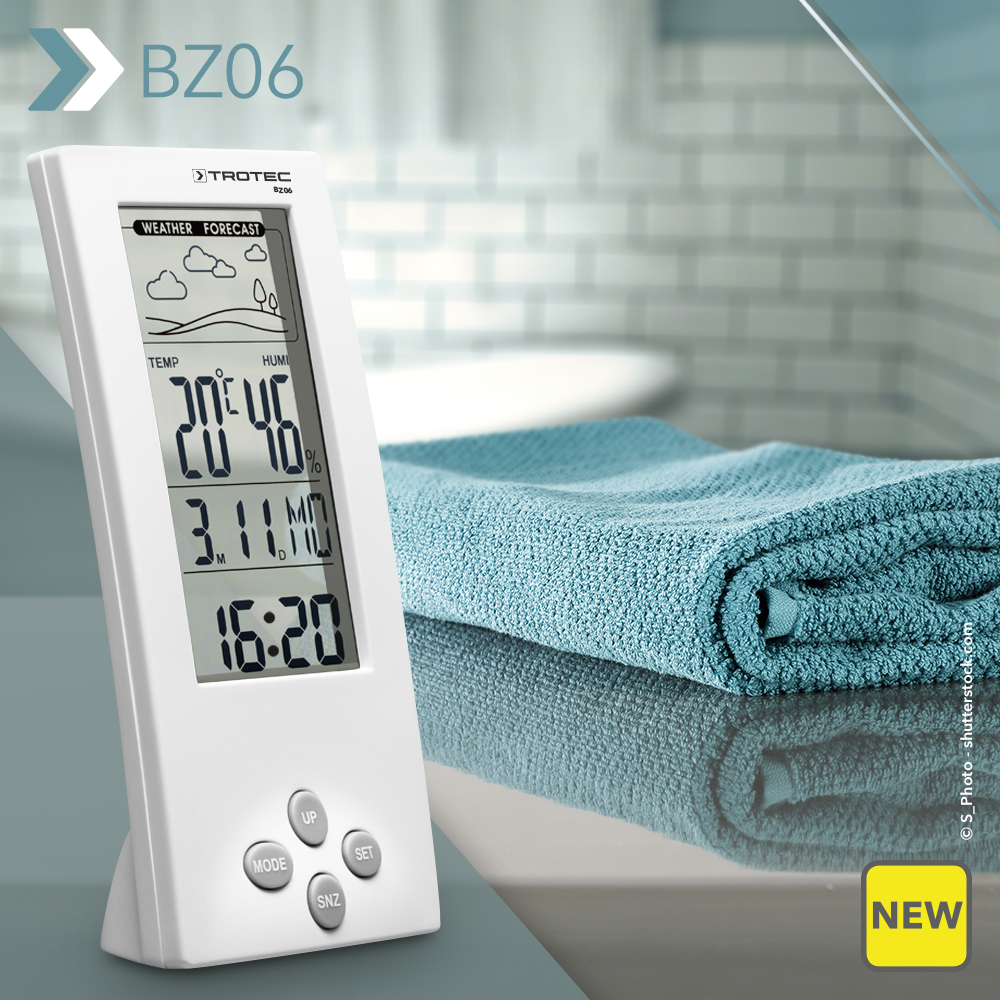 Finally an indoor climate station that not only promises an overview of all the relevant temperature data, but also guarantees a crystal-clear view. That’s provided on the one hand by the simultaneous display of the weather trend, time, date, room temperature and air humidity, and on the other by the stylish transparent LCD, which excites its users day after day. The integrated alarm, with a snooze function of course, rounds off the features of the both elegant and practical BZ06 thermohygrometer.
Finally an indoor climate station that not only promises an overview of all the relevant temperature data, but also guarantees a crystal-clear view. That’s provided on the one hand by the simultaneous display of the weather trend, time, date, room temperature and air humidity, and on the other by the stylish transparent LCD, which excites its users day after day. The integrated alarm, with a snooze function of course, rounds off the features of the both elegant and practical BZ06 thermohygrometer.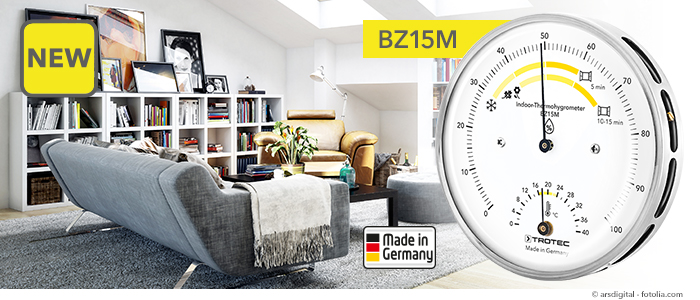 What many don’t know: In winter, the relative humidity of a 20 °C room should not exceed 40-50 % in order to avoid the growth of harmful mould. In cases like this, the humidity can be lowered through consistent airing, providing one is aware of the danger in the first place. From now on, the new BZ15M Living Climate Hygrometer will take care of it – it shows the optimal indoor climate values in an easy-to-read and understandable manner.
What many don’t know: In winter, the relative humidity of a 20 °C room should not exceed 40-50 % in order to avoid the growth of harmful mould. In cases like this, the humidity can be lowered through consistent airing, providing one is aware of the danger in the first place. From now on, the new BZ15M Living Climate Hygrometer will take care of it – it shows the optimal indoor climate values in an easy-to-read and understandable manner.